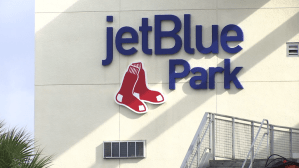
Boston Red Sox spring training kicks off at JetBlue Park
Spring training season is officially underway, and the Boston Red Sox are set to play their first Grapefruit League game at JetBlue Park on Sunday.

How could you live in the Sunshine State and not soak up the sun on our beautiful beaches?
From Englewood Beach to Lover’s Key, beaches are a hang-out spot so many of us take advantage of, but they weren’t always available to everyone.
In fact, within just the last 60 years people with darker skin were only allowed to go to one beach in southwest Florida.
For Black History Month, WINK spoke with a woman who grew up going to Bunche Beach and talked about the progress we’ve made as a community.
Vivian Watkins was born and raised in Lee County.
“My adolescent years, grew up on Blake Street, and often went out to visit with my grandparents, Louisza, and Matt Curtis that lived in Iona,” Watkins said.
She remembers all the good times with her family, her grandparents, her mom and dad, aunt and uncle, who, in the 1950s, worked the concession stand at Bunche Beach.
“Often, the high school students from Dunbar High School, when they were out of school, they would come there, have fun, and then on the weekend, I would be there with my aunt and uncle and was able to help out at the concession stand,” Watkins said.
But times were different back then.
“Through that time, as I was growing up, I did experience and witness the segregation. The Bunche Beach, it was a black beach,” Watkins said.
Bunche Beach was the only beach black people could go to during segregation.
It’s named after Dr. Ralph Bunche, the first black American Nobel Peace Prize recipient. Its history is honored at the Williams academy black history museum operated by the Lee County Black History Society.
Charles Barnes is the chairman.
“My father would take us. My father was a police officer here, and so he would take his family out to the beach, and he would always take us a Bunche Beach where he also worked as a patrolman at the time. Black officers could only work in areas where there were black people,” Barnes said.
Barnes said that like Vivian, he and his family couldn’t go to Fort Myers Beach, Sanibel, Naples or Marco Island.
Bunche Beach was the only option.
Vivian was asked how she felt knowing that that’s how times were.
“I was very inquisitive and asked questions. I could remember going in stores, and my dad would always have to go to the back door, and I would ask him, I’d say, ‘Dad, why do we have to go in the back door?’ And he would tell me, ‘Honey, we are not allowed to go in the front door because of segregation and everything being separate. We’re not allowed to.’ But it made me feel not in a sense, bad, but I knew that things would soon change, that it couldn’t be that way forever.”
Things did change but not until 1969.
Vivian was asked what it was like when she was able to go to other beaches.
“It felt like being inclusive, and there was a little fear because I guess it was the fear of the unknown because I didn’t know how I would be treated by other white children, white people, but it was sort of a fear of [the] unknown.”
She was asked how people treated each other.
“You could tell that there was some kind of friction there. That, it wasn’t that they were really grasping and wanting to connect with us, and it was a very slow process.”
Today, every beach is open to anyone of any color, but ask Vivian and Barnes to compare where we are today to before desegregation. They both said that there has been a lot of progression but that there is still a lot of work to be done.